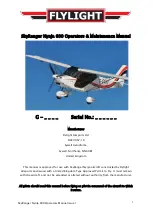
F
F
L
L
I
I
G
G
H
H
T
T
T
T
R
R
A
A
I
I
N
N
I
I
N
N
G
G
S
S
U
U
P
P
P
P
L
L
E
E
M
M
E
E
N
N
T
T
for SPORT
STAR
Light Sport Aircraft
Document No.: S2006FTSUS Revision: -
Date of Issue: 15/01/2006
Page:
68/130
4.7.2
Checks during taxiing
1. Check that the parking brake (if installed) is released (otherwise
the toe-brake pedals are disengaged ).
2. Set the throttle to the idle position. The airplane should not start to
move after releasing the toe-brake pedals with the power set to
idle.
3. Switch on the radio, intercom, transponder to standby, Navigation
instruments and other required instruments and equipment
(position lights , beacon etc.)
4. When taxiing at a controlled airport, contact the appropriate ATC
frequency and get a clearance.
5. Visually check that the area is free in the direction of taxiing.
6. Release the toe-brake pedals.
7. Turn the throttle lever to smoothly increase engine power. The
airplane should slowly start to move. The rpm required to make
the airplane move forward depends on the condition of the taxiway
surface (higher on a grass runway than on a paved runway).
8. After the airplane starts to move you can decrease engine speed
so that the airplane taxis at a slow speed. The recommended taxi
speed is less than 15 km/h, 8 knots.
Recommended rpm for taxiing is within 2000 to 2500 rpm. The
speed of taxiing should always be adjusted to suit the conditions of
the airport (runway condition, width, free area, persons etc.)
9. It is recommended to turn on all gyroscopic instruments (artificial
horizon etc.) if installed. This will allow them to start to rotate and
stabilize the rotation of the gyros. If a GPS is installed it is also
recommended to switch it on in order to have enough time to find
satellites. Normally , the flight route is already programmed into
the GPS.
















































